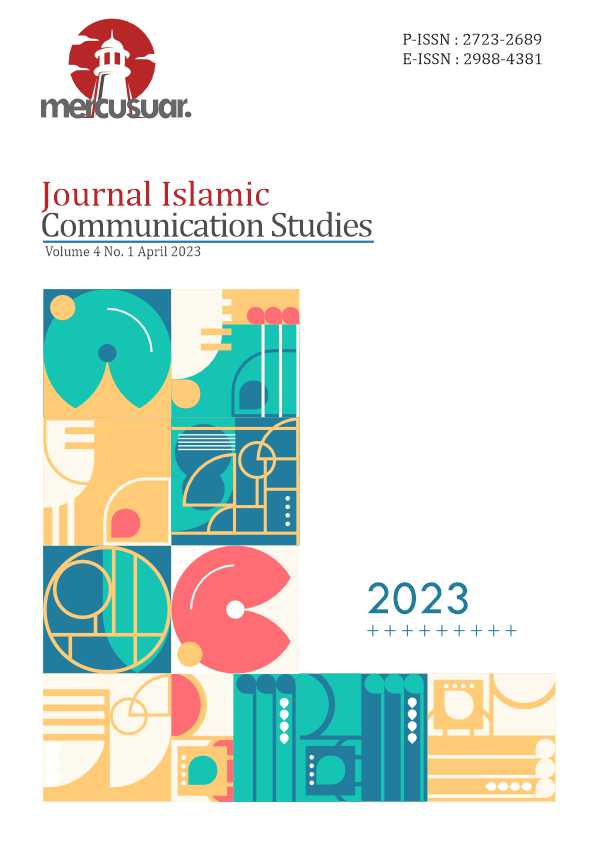The Influence of Village Family Planning Campaign Communication on the Awareness of Family Planning Acceptors in Sinjai District
Abstract
This study aims to examine the impact of the "kampung KB" campaign on the awareness increase of KB acceptors in Sinjai District.
The type of this research is a survey using a quantitative approach. The respondents in this study amounted to 262 individuals, obtained through proportional cluster random sampling. Data was collected using a questionnaire instrument, which was analyzed using descriptive and inferential statistics.
Based on the descriptive analysis, the implementation of the "kampung KB" campaign falls into a moderate category in terms of message delivery and the accuracy of the message content for KB acceptors, with a percentage of 45% or 118 respondents.
Meanwhile, the variable regarding the awareness increase of KB acceptors in accepting KB is in the moderate category, with a percentage of 40.8% or 107 respondents.
The inferential analysis results indicate that the statistical hypothesis testing of the "kampung KB" campaign using SPSS 25 yielded a t-table analysis result < t-calculated value (2.132 < 11.408) and a significance of 0.000 < 0.05. This means the null hypothesis (Ho) is rejected and the alternative hypothesis (Ha) is accepted. It can be concluded that the "kampung KB" campaign has a positive and significant effect on the awareness increase of KB acceptors in Sinjai District.
This study highlights the need to enhance the involvement of various sectors in the family planning campaign and the participation of KB acceptors in educating couples of reproductive age about contraceptive methods. Although the focus is on three sub-districts in Sinjai District, the results do not represent the entirety of "kampung KB". By only examining one variable, the "kampung KB" campaign, and using a questionnaire-based survey method, there's potential for other influencing factors that remain unexplored, leading to conclusions based on limited data.
Downloads
References
Kabupaten Sinjai Dalam Angka 2020, (Kabupaten Sinjai, Percetakan Damai, 2020).
M. Munandar Soelaeman, Ilmu Sosial Dasar: Teori dan Konsep Ilmu Sosial, (Cet.VIII; Bandung:PT Eresco, 1995).
Annisa Nurmahdalena, “Peran Penyuluh Keluarga Berencana (PKB) dalam Pengendalian Pertumbuhan Penduduk”, Jurnal Universitas Mulawarman, Samarinda, Vol. IV, 2016.
http://www.lusa.web.id/perkembangan-kbdi-indonesia/. Di akses pada tanggal 27 Februari 2021
Departemen Agama RI, Al-Qur’an dan Terjemahannya, (Bandung : CV Penerbit J-ART, 2004).
Wahbah Az-Zuhaili, Fiqih Islam wa Adillatuhu Pernikahan, Talak, Khulu, Meng-Illa’, Istri Li’an, Zhihar, Masa Iddah, (Jakarta; Gema Insani, 2011).
Himpunan Fatwa Majelis Ulama Indonesia, Bagian Proyek Sarana dan Prasarana Produk Halal Direktorat Jenderal Bimbingan Masyarakat Islam dan Penyelenggaraan Haji Departemen Agama RI 2003.
Himpunan Fatwa Majelis Ulama Indonesia.
Abuya Shufiyyah, Pandangan Islam tentang Keluarga. https://sholihinmuttaqin.blogspot.com/2016/10/pandangan-islam-tentang-keluarga.html di akses pada tanggal 12 september 2021.
Yurike Septianingrum dan dkk, faktor-faktor yang mempengaruhi tingginya akseptor KB suntik 3 bulan. Jurnal Ners dan Kebidanan, Vol. 5 No.1 2018.
https://bugispos.com/2020/10/26/ini-mi-jumlah-peserta-kb-di-sinjai-periode-januari-september-2020/ diakses pada tanggal 10 juni 2021.


